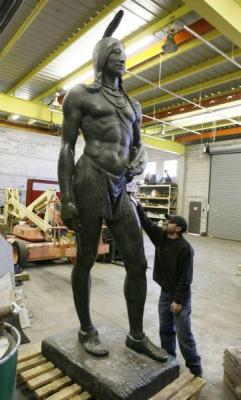Meanwhile, on with the debate.
Thanks for the info, curator. This discussion is relatively timely since we've just seen Massasoit portrayed in the After the Mayflower episode of PBS's We Shall Remain series. Readers should peruse your full response to learn more about him and Dallin.
One could consider Dallin's multiple castings of one statue a "fetish," of course. Or at least a sign of self-satisfaction with his work. He facilitated the dissemination of his vision of the "noble savage." That's all I meant with that comment.
Eager to display stereotypes
Besides, whether Utah eagerly commissioned the statue or eagerly accepted it as a gift is a minor point to me. The main point is Utah's eagerness to display a stereotypical image of Indians. Feel free to address this point.
As Sweet-Hart said, Dallin gave Utah his original plaster figure of Massasoit, not a bronze statue. Apparently the state commissioned someone to cast the statue from that. In other words, it paid someone to transform the plaster figure into a metal figure--an act of commission.
The point is that Utah was an active participant in the stereotyping of Indians, not merely a passive recipient. The state is continuing this attitude by proudly displaying the statue while ignoring Utah's real Indians. Again, feel free to address the point.
What the statue represents
Your position is that Dallin was interpreting only the Pilgrims' first sighting of the noble Massasoit standing on a hill. My position is that he was interpreting the whole history of Indians from his Mormon perspective: the lost tribesman of Israel welcoming his lost brothers, the uncivilized savage showing off his animal-like qualities, the "creature" doomed to become extinct as America fulfilled its Manifest Destiny.
Unless Dallin left notes about his intent, we can't be sure whose speculation is correct. And even if Dallin explicitly said he was only thinking of the first view of Massasoit, I wouldn't necessarily buy it. I'm speculating about his unconscious motives as well as his conscious ones.
Besides, our two positions aren't incompatible. Dallin's statue could represent his interpretation of the first meeting and the symbolism of the "noble savage," with all it implies. The "noble savage" concept was well-known at the time and Dallin must've been familiar with it. Unless someone can prove he didn't know about it, I'd say it had to have influenced him.
You didn't say exactly what you'd recommend doing with it. Are you arguing that it should retain its place of prominence? That it should be the first Indian people see when they visit Utah's Capitol?
If that's your position, see above about what the statue represents. Are you comfortable sending that message to people who know little or nothing about Indians? Whose only exposure to them has been the half-naked "noble savages" they've seen in Thanksgiving pageants and Western movies?
Because I'm not comfortable with that. And I suspect most of Utah's Indians wouldn't accept that position either. I say move the statue and stop misinforming the public about Indians.
For more on the subject, see Thanksgiving in After the Mayflower and Massasoit Statue in Utah.


No comments:
Post a Comment
Note: Only a member of this blog may post a comment.